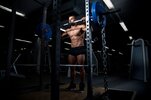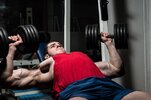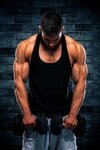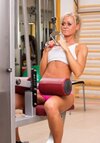01dragonslayer
Ripped
- Jacked Cash
- 470,698
The Anabolic Diet is a book/diet that was written/introduced into the health and fitness subculture in 1995 by Dr. Mauro Di Pasquale, a licensed physician from Ontario, Canada that has vested interests in sports medicine and nutrition. The Anabolic Diet is essentially Dr. Mauro Di Pasquale’s twist on a cyclical ketogenic diet (CKD).
Aside from his educational background in molecular biology and genetics and completion of his medical degree, Dr. Di Pasquale was a world-class powerlifter in the late 1970s. After he was finished competing he opened up his own practice to help athletes and even just lay-people achieve their health and fitness goals. The Anabolic Diet is one of his first compositions, and he has since written a handful of other pertinent books.
But just because the Anabolic Diet is one of his older works doesn’t mean it isn’t still useful today, if anything it has quite a few worthwhile principles behind it. This guide will delve into what the Anabolic Diet is, the proposed science behind it, how to start your own Anabolic Diet regimen, and answer some frequently asked questions about it.
Given that ketogenic diets are inherently very low in carbohydrates (generally <10% of total macronutrient intake) and higher in proteins and fats the body is diverted to utilize fats for energy since glucose stores are depleted. While ketogenic diets are often used mainly for health and fitness purposes, they are also implemented in medicine as treatment for epilepsy. [1]
While Dr.Di Pasquale asserts that the Anabolic Diet is not a ketogenic diet in the strict sense, it is still based around some of the same physiological principles. Unlike conventional dieting strategies that focus specifically on building muscle or burning fat for extended periods of time, the Anabolic Diet is a tri-phasic diet comprised of: maintaining, bulking, and cutting.
If you’re wondering why the program is called the “Anabolic Diet” it’s because Dr. DiPasquale believes that macronutrient manipulation and food choices he recommends are conducive to maximizing your endocrine system functioning. He has made the boisterous claim that the diet has “steroid-like” effects but that’s a bit overzealous.
Maintenance/”Induction” Phase (Weeks 1-4): Maintenance calorie intake, which Dr. DiPasquale suggests is 18 multiplied by your body mass in pounds. This is also called the “induction” phase because the program uses this period to accustom your body to the macronutrient manipulation behind the Anabolic Diet (which we will soon discuss).
Bulk Phase (length will vary based on factors described below): The bulk phase is a bit different in that the calorie content may need adjusting after a few weeks of trial and error. To establish your starting calorie intake for the bulking phase, Dr. DiPasquale suggests using your “ideal body weight (in pounds)” and adding 15% to that number. So let’s say our trainee in question has an ideal bodyweight of 180lbs, he would then be aiming to bulk up to ~207lbs.
The bulk phase basically lasts until this “overshooting” estimation is achieved, and Dr. DiPasquale believes the calorie intake should land between 20-25 calories per pound of the desired body mass (in pounds) each day. If you are gaining more than 2lbs of body mass per week you should back the calories down a bit. Contrarily, if you aren’t gaining much weight, you may need to bump calorie intake up.
This phase should ideally run until you A) achieve your desired ideal body mass + 15%, or you B) get over 10% body-fat.
Cutting Phase (length will vary based on factors described below): The cutting phase is pretty much the same as maintenance phase but with a slight drop in calories to achieve the desired weight loss each week. Dr. DiPasquale submits that a 500-1000 daily calorie deficit should be plenty. He also notes that weight loss of >2lbs per week is a bit too extreme and most of that weight loss will be muscle mass; aim for 1-1.5lbs per week.
To determine your daily calorie intake in this phase, take your body mass (in pounds) and multiply it by 18, then subtract between 500-1000 calories from that number.
This phase should be run until you achieve a desired body-fat percentage, preferably <10%.
Weekday timeframe: Focus on greatly limiting carbohydrate intake (i.e. <30g per day) and increasing energy intake from fat and protein sources. Your macronutrient proportions should breakdown as about 60-65% fats, 30-35% protein, and the rest is carbohydrates.
Weekend timeframe: The weekends are meant to replenish muscle glycogen and help restore your sanity if you’ve been craving carbs. High-carb day macronutrients are pretty much the inverse of weekdays and breakdown as about 10-20% fat, 10-20% protein, and the rest from carbohydrates (60-80%).

However, literature seems to suggest that chronic high-fat diets can induce insulin resistance, which would be rather detrimental to the carb-loading phase on weekends of the Anabolic Diet.[3] Moreover, the drawback to restricting carbohydrate intake during the weekdays is that insulin secretion will remain minimal and limit the anabolic response to meals. Keep in mind that insulin is a highly anabolic hormone, and it has been shown to propel the muscle protein synthesis response to meals beyond that of protein-only feedings.[4]

As with most any other dieting strategy, it is wise to experiment and find what works for you and your body. Some people might flourish while using the Anabolic Diet and find it keeps them performing better, while others may do better on a more balanced diet that doesn’t have large swings in certain macronutrients.
2. Dorgan, J. F., Judd, J. T., Longcope, C., Brown, C., Schatzkin, A., Clevidence, B. A., ... & Taylor, P. R. (1996). Effects of dietary fat and fiber on plasma and urine androgens and estrogens in men: a controlled feeding study. The American journal of clinical nutrition, 64(6), 850-855.
3. Kraegen, E. W., Clark, P. W., Jenkins, A. B., Daley, E. A., Chisholm, D. J., & Storlien, L. H. (1991). Development of muscle insulin resistance after liver insulin resistance in high-fat–fed rats. Diabetes, 40(11), 1397-1403.
4. Kimball, S. R., Jurasinski, C. V., Lawrence, J. C., & Jefferson, L. S. (1997). Insulin stimulates protein synthesis in skeletal muscle by enhancing the association of eIF-4E and eIF-4G. American Journal of Physiology-Cell Physiology, 272(2), C754-C759.
Aside from his educational background in molecular biology and genetics and completion of his medical degree, Dr. Di Pasquale was a world-class powerlifter in the late 1970s. After he was finished competing he opened up his own practice to help athletes and even just lay-people achieve their health and fitness goals. The Anabolic Diet is one of his first compositions, and he has since written a handful of other pertinent books.
But just because the Anabolic Diet is one of his older works doesn’t mean it isn’t still useful today, if anything it has quite a few worthwhile principles behind it. This guide will delve into what the Anabolic Diet is, the proposed science behind it, how to start your own Anabolic Diet regimen, and answer some frequently asked questions about it.
What are cyclic ketogenic diets (CKDs)?
Before jumping into the principles behind the Anabolic Diet, it’s useful to have a rudimentary understanding of CKDs in general. CKDs are basically diets that focus on periods of low-carb dieting followed by a brief “carb loading” phase to restore glycogen.Given that ketogenic diets are inherently very low in carbohydrates (generally <10% of total macronutrient intake) and higher in proteins and fats the body is diverted to utilize fats for energy since glucose stores are depleted. While ketogenic diets are often used mainly for health and fitness purposes, they are also implemented in medicine as treatment for epilepsy. [1]
The Anabolic Diet
 Principles behind the Anabolic Diet
Principles behind the Anabolic Diet
While Dr.Di Pasquale asserts that the Anabolic Diet is not a ketogenic diet in the strict sense, it is still based around some of the same physiological principles. Unlike conventional dieting strategies that focus specifically on building muscle or burning fat for extended periods of time, the Anabolic Diet is a tri-phasic diet comprised of: maintaining, bulking, and cutting.If you’re wondering why the program is called the “Anabolic Diet” it’s because Dr. DiPasquale believes that macronutrient manipulation and food choices he recommends are conducive to maximizing your endocrine system functioning. He has made the boisterous claim that the diet has “steroid-like” effects but that’s a bit overzealous.
Anabolic Diet phases
Each phase of the diet merely alters the caloric intake to support the intended goal of maintaining, gaining, or losing weight. The macronutrient composition of the diet remains proportional to the calorie content (we’ll talk more about macronutrient manipulation later). The length of each phase can be customized based on your current body-fat levels and your goals. A typical “cycle” may look like this:Maintenance/”Induction” Phase (Weeks 1-4): Maintenance calorie intake, which Dr. DiPasquale suggests is 18 multiplied by your body mass in pounds. This is also called the “induction” phase because the program uses this period to accustom your body to the macronutrient manipulation behind the Anabolic Diet (which we will soon discuss).
Bulk Phase (length will vary based on factors described below): The bulk phase is a bit different in that the calorie content may need adjusting after a few weeks of trial and error. To establish your starting calorie intake for the bulking phase, Dr. DiPasquale suggests using your “ideal body weight (in pounds)” and adding 15% to that number. So let’s say our trainee in question has an ideal bodyweight of 180lbs, he would then be aiming to bulk up to ~207lbs.
The bulk phase basically lasts until this “overshooting” estimation is achieved, and Dr. DiPasquale believes the calorie intake should land between 20-25 calories per pound of the desired body mass (in pounds) each day. If you are gaining more than 2lbs of body mass per week you should back the calories down a bit. Contrarily, if you aren’t gaining much weight, you may need to bump calorie intake up.
This phase should ideally run until you A) achieve your desired ideal body mass + 15%, or you B) get over 10% body-fat.
Cutting Phase (length will vary based on factors described below): The cutting phase is pretty much the same as maintenance phase but with a slight drop in calories to achieve the desired weight loss each week. Dr. DiPasquale submits that a 500-1000 daily calorie deficit should be plenty. He also notes that weight loss of >2lbs per week is a bit too extreme and most of that weight loss will be muscle mass; aim for 1-1.5lbs per week.
To determine your daily calorie intake in this phase, take your body mass (in pounds) and multiply it by 18, then subtract between 500-1000 calories from that number.
This phase should be run until you achieve a desired body-fat percentage, preferably <10%.
Anabolic Diet macronutrient cycling
While the phases of the diet each have respective calorie intake goals, the macronutrient proportions inherent in the Anabolic Diet remain unaltered during all phases. Dr. DiPasquale has split the diet into two timeframes—Low-carb weekdays and high-carb weekends.Weekday timeframe: Focus on greatly limiting carbohydrate intake (i.e. <30g per day) and increasing energy intake from fat and protein sources. Your macronutrient proportions should breakdown as about 60-65% fats, 30-35% protein, and the rest is carbohydrates.
Weekend timeframe: The weekends are meant to replenish muscle glycogen and help restore your sanity if you’ve been craving carbs. High-carb day macronutrients are pretty much the inverse of weekdays and breakdown as about 10-20% fat, 10-20% protein, and the rest from carbohydrates (60-80%).

Purported physiology behind the Anabolic Diet
The Anabolic Diet is based primarily around the idea that very-low carbohydrate diets force the body to derive energy from fats and/or amino acids since glucose is scarce. The second notion behind the Anabolic Diet is that androgen production is correlated with saturated fat intake. [2]However, literature seems to suggest that chronic high-fat diets can induce insulin resistance, which would be rather detrimental to the carb-loading phase on weekends of the Anabolic Diet.[3] Moreover, the drawback to restricting carbohydrate intake during the weekdays is that insulin secretion will remain minimal and limit the anabolic response to meals. Keep in mind that insulin is a highly anabolic hormone, and it has been shown to propel the muscle protein synthesis response to meals beyond that of protein-only feedings.[4]
Anabolic Diet food choices
Dr. DiPasquale is pretty firm on his stance that saturated fats are a good fuel source and essential for optimal hormone production. Thus, for weekdays (low-carb days), he tends to suggest:- Fatty cuts of animal proteins (especially red meats)
- Whole eggs
- Full-fat dairy products like cheese, cream, butter etc.
- Oils, preferably canola, peanut, flax, macadamia, olive, and coconut varieties
- Nuts and nut spreads
- Fibrous vegetables, especially greens like lettuce, broccoli, celery, etc.
Sample weekday menu (~2800 calories):
Meal 1
- 3 Whole Eggs with 1oz Pepperjack Cheese cooked in 1 Tsp Oil
- 2 Turkey Sausage Links
- 10g Peanut Butter
Meal 2
- 4oz. Ground Pork
- 1 Italian Sausage
- 1.5 Cup Salad Mix
 Meal 3
Meal 3
- 4oz. 93/7 Ground Beef w/1oz Pepperjack Cheese
- 1 Turkey Sausage Link
- 32g Peanut Butter
Meal 4
- 5oz. White-meat Chicken Breast cooked in 1Tbsp Oil
- 1 Turkey Sausage Link
- 1.5 Cup Salad Mix w/1 Tbsp Flaxmeal
- 21g Peanut Butter
Meal 5
- 6oz 1% Cottage Cheese
- 1/2 Scoop Whey Protein
- 16g Almond Butter
- 5g Flaxmeal
- 1 Tbsp Oil
Pre/Post Workout Shakes
- 1.5 Scoop Whey before workout
- 2 Scoop Whey after workout
Daily Totals
- 2840 Calories
- 165g Fat of which about 40 were Saturated Fat
- 265g Protein
- ~30g Net Carb
Sample Weekend Menu (portions will vary based on your calorie intake):
- Meal 1 - Pancakes, fresh fruit and an egg white omelet
- Meal 2 - Pasta w/tomato sauce, chicken breast, and garlic bread
- Meal 3 - Bagel with low-fat cheese and turkey breast
- Meal 4 - Sweet potato and an extra-lean ground beef hamburger
- Meal 5 - Shrimp tacos served over rice and beans

FAQs about the Anabolic Diet
Q: If I’m a vegan can I still follow the Anabolic Diet?
A: Yes, but the low-carb phase of the diet will be a bit tricky since you can’t (or won’t) ingest eggs, animal proteins, dairy, etc. It will be rather cumbersome to try and eat enough protein this way unless you use supplemental sources.Q: What supplements can I take while on the Anabolic Diet?
A: Pretty much anything you would take on any other diet can be used on the Anabolic Diet. However, it’s probably not wise/applicable to use mass gainers and other high-carb supplements during the low-carb portion of the diet.Q: Will the Anabolic Diet really give me “steroid-like” muscle gains?
A: Not likely, just being honest.Q: Is this diet safe for someone with high cholesterol?
A: If you have any medical/health conditions it is most wise to direct your questions to your physician.Q: Does fiber count against my total carbohydrate intake?
A: The Anabolic Diet does not count fiber as a part of the “net carb” intake. However, fiber does still contain calories like any other macronutrient.Q: Should I use a fiber supplement, like psyllium husks, during the weekdays while following the Anabolic Diet?
A: This is up to you, but if you’re not eating many fibrous vegetables it might be prudent to include a fiber supplement to maintain healthy gastrointestinal functioning.Q: I feel very bloated and lethargic on the weekends after carb-heavy meals, what should I do?
A: You can try and increase meal frequency and distribute your carbohydrates out more or try eating the majority of your carbohydrates later in the day since you’re likely going to be relaxing/inactive at night anyway.Q: Is it normal to feel “out of it”/sluggish during the initiation/start-up phase of the Anabolic Diet?
A: Dr. DiPasquale says it can take a few weeks for the body to adjust to the Anabolic Diet, especially if you are coming from a diet that was based around higher-carb intake.Q: What should I do if I’m already over 10% BF and want to follow the Anabolic Diet?
A: Do it is outlined in this guide but simply skip the bulking phase. Once you reach your desired body fat percentage under 10% you can restart the diet and incorporate the bulking phase.Anabolic Diet Wrap up
Dr. DiPasquale has gained a large following over the years, and much of that started with the influence the Anabolic Diet had on health/fitness subculture. While the diet does have some sound principals behind it, it does have a few drawbacks and may not be suitable for everybody.As with most any other dieting strategy, it is wise to experiment and find what works for you and your body. Some people might flourish while using the Anabolic Diet and find it keeps them performing better, while others may do better on a more balanced diet that doesn’t have large swings in certain macronutrients.
References:
1. Ketogenic Diet. (n.d.). Epilepsy Foundation. Retrieved October 30, 2013, from Epilepsy Foundation2. Dorgan, J. F., Judd, J. T., Longcope, C., Brown, C., Schatzkin, A., Clevidence, B. A., ... & Taylor, P. R. (1996). Effects of dietary fat and fiber on plasma and urine androgens and estrogens in men: a controlled feeding study. The American journal of clinical nutrition, 64(6), 850-855.
3. Kraegen, E. W., Clark, P. W., Jenkins, A. B., Daley, E. A., Chisholm, D. J., & Storlien, L. H. (1991). Development of muscle insulin resistance after liver insulin resistance in high-fat–fed rats. Diabetes, 40(11), 1397-1403.
4. Kimball, S. R., Jurasinski, C. V., Lawrence, J. C., & Jefferson, L. S. (1997). Insulin stimulates protein synthesis in skeletal muscle by enhancing the association of eIF-4E and eIF-4G. American Journal of Physiology-Cell Physiology, 272(2), C754-C759.

